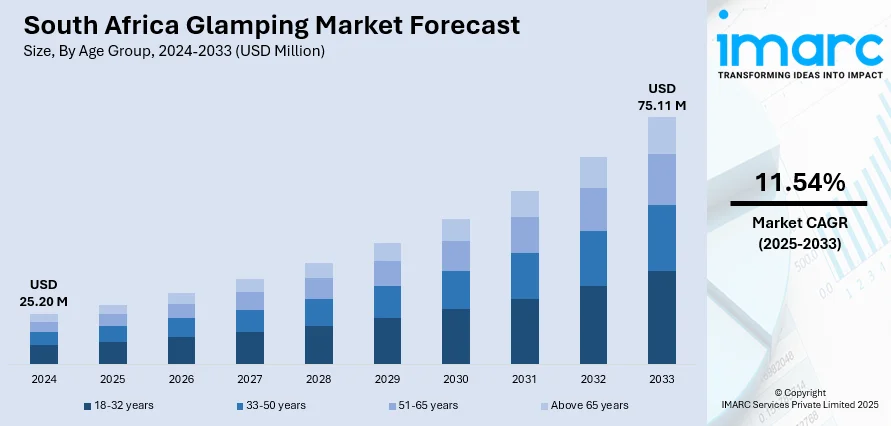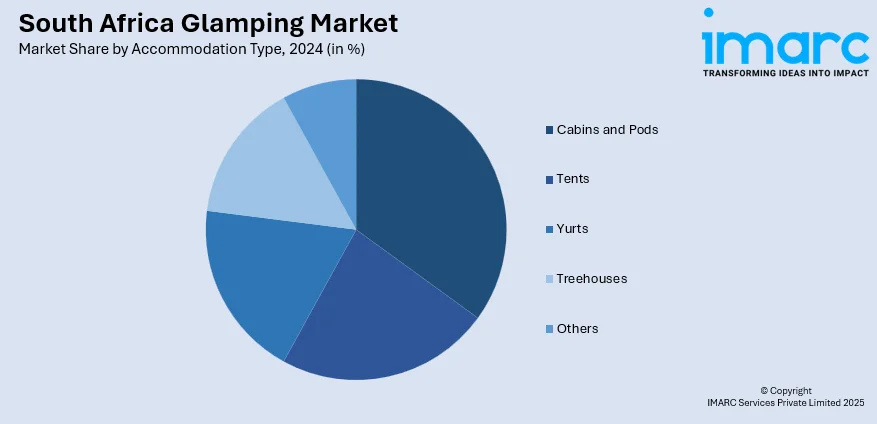
South Africa Glamping Market Size, Share, Trends and Forecast by Age Group, Accommodation Type, Booking Mode, and Province, 2025-2033
South Africa Glamping Market Overview:
The South Africa glamping market size reached USD 25.20 Million in 2024. The market is projected to reach USD 75.11 Million by 2033, exhibiting a growth rate (CAGR) of 11.54% during 2025-2033. The market is driven by growing domestic and international tourism, fueled by the country's diverse biodiversity, breathtaking landscapes, and culture. Furthermore, increasing demand for sustainable and experience travel has further boosted glamping sector development. Additionally, advances in digital reservation platforms and government tourism campaigns targeting specific segments also keep promoting visibility and access to glamping spots, which is further augmenting the South Africa glamping market share.
|
Report Attribute
|
Key Statistics
|
|---|---|
|
Base Year
|
2024
|
|
Forecast Years
|
2025-2033
|
|
Historical Years
|
2019-2024
|
| Market Size in 2024 | USD 25.20 Million |
| Market Forecast in 2033 | USD 75.11 Million |
| Market Growth Rate 2025-2033 | 11.54% |
South Africa Glamping Market Trends:
Rise of Eco-Tourism and Conservation-Oriented Travel
The glamping sector is witnessing a robust move towards eco-tourism, driven by increasing environmental awareness among domestic tourists and international tourists. This is closely related to the overall development of the tourism sector, which received 2.4 Million foreign visitors in the first quarter of 2024, growing by 15.4% from the same quarter in 2023. As tourism continues to expand, the need for accommodation with minimal environmental impact and nature-based experiences is on the rise. Glamping, with the potential to blend comfort and sustainability, is emerging as a viable replacement for conventional accommodations. Moreover, several travelers are choosing environmentally friendly accommodations that reflect responsible tourism principles, prompting operators to embrace green building design, renewable energy, and conservation-based guest experiences. Glamping operators are responding by incorporating eco-friendly amenities like solar-powered tents, composting toilets, rainwater harvesting systems, and biodegradable products. In addition, strategic collaboration with local conservation initiatives and NGOs provides visitors with educational experiences regarding biodiversity, anti-poaching, and ecosystem conservation. The market growth is also facilitated by South Africa's legislative and policy structures that enhance sustainable tourism development. With ecological stewardship as a core value proposition, glamping companies are taking advantage of this trend to differentiate themselves in an aggressive market while ensuring long-term environmental sustainability and socio-economic gains for local communities.

To get more information on this market, Request Sample
Digitalization of Travel Planning and Glamping Bookings
Digitalization is among the key drivers of the South Africa glamping market growth, especially with tech-savvy consumers requiring effortless, personalized, and mobile-first travel experiences. According to industry reports, over half of South Africa's population had access to 5G networks, significantly improving mobile internet speeds and supporting more sophisticated digital services. This infrastructure advancement has allowed glamping operators, many of whom are in remote or rural areas, to effectively market their offerings through online travel agencies (OTAs), dedicated glamping platforms, and social media campaigns. Besides this, the utilization of virtual tours, influencer collaborations, and consumer-generated content on Instagram and TikTok is instrumental in shaping travel behavior. These online platforms not only generate engagement but also enable companies to monitor consumer needs and customize the delivery of services. Besides this, mobile itinerary planning apps, digital concierge apps, and real-time guest feedback are the new norms among premium glamping services. With continued internet penetration in rural parts of South Africa, the incorporation of digital solutions will further enhance efficiency and enhance customer relations within the glamping sector.
South Africa Glamping Market Segmentation:
IMARC Group provides an analysis of the key trends in each segment of the market, along with forecasts at the country and regional levels for 2025-2033. Our report has categorized the market based on age group, accommodation type, and booking mode.
Age Group Insights:
- 18-32 years
- 33-50 years
- 51-65 years
- Above 65 years
The report has provided a detailed breakup and analysis of the market based on the age group. This includes 18-32 years, 33-50 years, 51-65 years, and above 65 years.
Accommodation Type Insights:

- Cabins and Pods
- Tents
- Yurts
- Treehouses
- Others
A detailed breakup and analysis of the market based on the accommodation type have also been provided in the report. This includes cabins and pods, tents, yurts, treehouses, and others.
Booking Mode Insights:
- Direct Booking
- Travel Agents
- Online Travel Agencies
The report has provided a detailed breakup and analysis of the market based on the booking mode. This includes direct booking, travel agents, and online travel agencies.
Province Insights:
- Gauteng
- KwaZulu-Natal
- Western Cape
- Mpumalanga
- Eastern Cape
- Others
The report has also provided a comprehensive analysis of all the major regional markets, which include Gauteng, KwaZulu-Natal, Western Cape, Mpumalanga, Eastern Cape, and others.
Competitive Landscape:
The market research report has also provided a comprehensive analysis of the competitive landscape. Competitive analysis such as market structure, key player positioning, top winning strategies, competitive dashboard, and company evaluation quadrant has been covered in the report. Also, detailed profiles of all major companies have been provided.
South Africa Glamping Market News:
- On 20 June 2025, South Africa’s Minister of Tourism welcomed the inaugural Glamping Expo in Johannesburg, describing it as a timely and innovative advancement for the country’s tourism sector. The minister emphasized that glamping has the potential to empower local communities while preserving natural habitats. The Expo serves as a strategic platform for sustainability, transformation, and industry collaboration, aligning with national objectives to diversify tourism offerings and promote inclusive economic growth.
South Africa Glamping Market Report Coverage:
| Report Features | Details |
|---|---|
| Base Year of the Analysis | 2024 |
| Historical Period | 2019-2024 |
| Forecast Period | 2025-2033 |
| Units | Million USD |
| Scope of the Report |
Exploration of Historical Trends and Market Outlook, Industry Catalysts and Challenges, Segment-Wise Historical and Future Market Assessment:
|
| Age Groups Covered | 18-32 years, 33-50 years, 51-65 years, Above 65 years |
| Accommodation Types Covered | Cabins and Pods, Tents, Yurts, Treehouses, Others |
| Booking Modes Covered | Direct Booking, Travel Agents, Online Travel Agencies |
| Provinces Covered | Gauteng, KwaZulu-Natal, Western Cape, Mpumalanga, Eastern Cape, Others |
| Customization Scope | 10% Free Customization |
| Post-Sale Analyst Support | 10-12 Weeks |
| Delivery Format | PDF and Excel through Email (We can also provide the editable version of the report in PPT/Word format on special request) |
Key Questions Answered in This Report:
- How has the South Africa glamping market performed so far and how will it perform in the coming years?
- What is the breakup of the South Africa glamping market on the basis of age group?
- What is the breakup of the South Africa glamping market on the basis of accommodation type?
- What is the breakup of the South Africa glamping market on the basis of booking mode?
- What is the breakup of the South Africa glamping market on the basis of province?
- What are the various stages in the value chain of the South Africa glamping market?
- What are the key driving factors and challenges in the South Africa glamping market?
- What is the structure of the South Africa glamping market and who are the key players?
- What is the degree of competition in the South Africa glamping market?
Key Benefits for Stakeholders:
- IMARC’s industry report offers a comprehensive quantitative analysis of various market segments, historical and current market trends, market forecasts, and dynamics of the South Africa glamping market from 2019-2033.
- The research report provides the latest information on the market drivers, challenges, and opportunities in the South Africa glamping market.
- Porter's five forces analysis assist stakeholders in assessing the impact of new entrants, competitive rivalry, supplier power, buyer power, and the threat of substitution. It helps stakeholders to analyze the level of competition within the South Africa glamping industry and its attractiveness.
- Competitive landscape allows stakeholders to understand their competitive environment and provides an insight into the current positions of key players in the market.
Need more help?
- Speak to our experienced analysts for insights on the current market scenarios.
- Include additional segments and countries to customize the report as per your requirement.
- Gain an unparalleled competitive advantage in your domain by understanding how to utilize the report and positively impacting your operations and revenue.
- For further assistance, please connect with our analysts.
 Request Customization
Request Customization
 Speak to an Analyst
Speak to an Analyst
 Request Brochure
Request Brochure
 Inquire Before Buying
Inquire Before Buying




.webp)




.webp)












